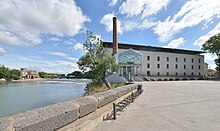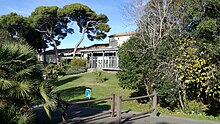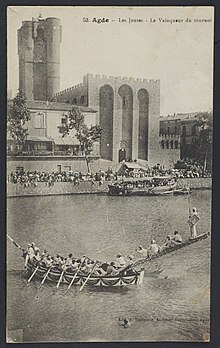Agde
Agde station has high-speed rail direct connections northbound to Paris, Lille, Geneva, southbound to Perpignan as well as Spain.
The inlet in the Hérault river, Grau d'Agde, became from the Antique to the Eighteenth century period the most important port in this occitanian region of the Mediterranée for trade.
[8] From the beginning of the fifth century (until the French Revolution), the city of Agde developed in the upstream area that was not subject to flooding and was the seat of a bishopric.
[26] At the 19th century Belle Epoque, in the mediterranean shore, the development of the French Riviera with the Train Bleu[27][28] instituted winter aristocratic cosmopolitan tourism since 1880 around Monaco and its grand hotels;[29] An Agatha native Emmanuel Laurens,[30] an inherited millionaire, bought the "St Gervais Villa" in Saint-Raphaël, Var (1898).
After immediate World War II the summer mass tourism was created in campsites and in 1960s' some very large and high residences were integrated in the "new urbanism".
[41] The naturist campsite became an important tourist complex outside the city, and in its vicinity the tennis courts was the major theme for the development of housing estates.
Since 2007 the Sodéal (Economic development society of Agde and the coast (70% of capital owned by the town) ammenages the marinas on the Hérault river and the shore, main one Le Port de Cap d'Agde.
[46] Access to the city tunnel under the railroad line was opened in 2023, after two years of construction,[46] while the most central space, the Promenade and its market, is transformed with the digging of a scheduled car parking lot that began in 2023.
One of its canons (the seventh), forbidding ecclesiastics to sell or alienate the property of the church from which they derived their living, seems to be the earliest mention of the later system of benefices.
[60] And if the last vineyard of Bagnas is now very small below Château Maraval[61] with the Meyer distillery in ruins, walking in is a planed tourist-office leisure nowadays; its wine is better for "connoisseurs", old grape varieties producing piquette have been abandoned.
[54] The wine-growing area of the Bagnas reserve was reduced in 2019 with the urbanization of the border running from Château Maraval down to the naturist camp: the most expensive detached villas in the town are here, as well as those at the top of the Mont St Martin with panoramic sea views, which also had vineyards starting at Richelieu beach that disappeared with the urbanisation of 1970.
The Port of Cap d'Agde (main marina) was excavated following the Mission Racine in the old salt marsh, the Luno lagoon.
A small commercial area was built before the entrance, the one that makes the camp self-sufficient after it, and housing estates grew up on the seafront, filling the land up to the vacation villages of 1975.
The Agenouillade (Kneel) is built after a miraculous prayer by Our Lady (Mary, mother of Jesus) to avoid flooding in Agde in the Sixteenth century.
[71] Near by the Agde Round Lock, aside the rail-way (with a special station for a private stop), Château Laurens is a splendid furnished villa, dandy residence.
Inside is a gothic style "salon de concert" with original 19th century stained glass windows from Bézier's school.
[82] The modernist movement in the town design can be seen in social housing as well as institutional buildings such as retirement homes, hospital and hôtels.
[85] The new municipal and departmental swimming pool L'Archipel, cité de l'eau, is created in 2011, a wooden structure, glass roof.
The designer is Jean-Michel Wilmotte (architect), with its twin Spanish-style esplanades (Barcelona) (2018 the first one, 2020 the twins), tall circular buildings with large crenellations on the upper floors plus interior gardens, a new annex of the town hall, a new post office, a new congress centre (architect Philippe Bonon [87] and Hervé di Rosa), a new tourist office, ground floors a shopping area (housing starts from 2020 to 2024).
[88][89] Circular Casino Barrière (architect Philippe Bonon), is the first built with the today redevelopment of the Ile des Loisirs.
During the Council of Agde, assembled by the Catholic church in 506 AD, Christian laymen and ecclesiastics were prohibited from eating with Jews or hosting them.
[95] "In February 1939, Agde had a population of 9,000 when the army decided to build a camp at its gates to accommodate 25,000 Spanish “Retirada” republicans.
In May–June 1940, the town welcomed a large number of French refugees, as well as Belgians, Poles and Czechoslovakians, (including Jews), many of whom were interned in the camp.
To celebrate the memory of first 1601 historic tournament in town, in 2001 the city of Agde organised major festivities bringing together all the jousting societies of the region.
"[103] The declared competencies and responsibilities in place of the municipalities of the agglomeration are : "Agriculture, Quality of life, Water and wastewater treatment, Budget management, Environment, Housing, Leisure and Arts and Crafts (Media libraries, Swimming-pool), Heritage, Public transport (Cap'Bus).
"[104] For Agde's old town, an urban contract for social cohesion (CUCS) was signed between the Hérault-Méditerranée agglomeration community and the French government in 2007.
Since January 1, 2018, the law has assigned the block of competencies relating to Water Environment Management and Flood Prevention (GEMAPI) to the agglomeration [and not to town halls].
The territory is particularly exposed to a double risk, of flooding on the one hand, with a rich hydrographic network including the Hérault river and its watershed, and on the other, of marine submersion.
[103] Developing dry gardens, encouraging the planting of perennials, pruning trees and mowing stadium lawns with the pooling of equipment and machinery: the Agglomération's 100 employees keep public spaces clean.
"Eventually, part of Agde's green spaces will be able to be irrigated by treated water from the "POSIDONIA" wastewater treatment plant".







































